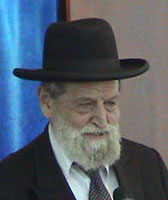Beit Midrash
- Sections
- Chemdat Yamim
- Parashat Hashavua
- Torah Portion and Tanach
- Bamidbar
- Korach
Let us look at the machloket with Korach. Why did there need to be two proofs that the Moshe/Aharon approach was correct – the swallowing up of Korach and the flowering of Aharon’s staff? The answer appears to emerge from the realization that there were two different disputes – about Moshe’s leadership and about the choice of Aharon as kohen gadol.
The first miracle (Bamidbar 16:28-30) was "called" by Moshe in advance. If the ground would open and swallow up Korach and his cohorts, it would prove that Moshe was correct in his leadership. Of course, Moshe succeeded. However, this solved only the issue of Moshe’s authority to decide.
The question of whether Aharon was the optimal choice was proven differently. Each of the tribes brought staffs, Aharon’s staff was placed among them, and Aharon’s staff grew flowers/fruit overnight. Moshe and not Aharon involved himself in this "contest" (ibid. 17:22-23). What is the difference between the two challenges?
Moshe held two leadership positions. The first was as the nation’s "political" leader, which required having the nation’s recognition and support. Not all the people did so originally, seeing him as just another human being, and some treated him with suspicion because he grew up as an Egyptian prince in Pharaoh’s court. As a political leader, Moshe had to negotiate with kings throughout the Middle East and take actions that were not popular with all the people.
Moshe’s second task was as the recipient and teacher of the Torah. In this task, he refrained from food and sleep for 40 days and went up to the Heaven to return with the Torah, which is of divine origin. He is the only person who merited to speak "face to face" with Hashem, and his extreme spirituality made it necessary to wear a mask after speaking to Him. Whoever argues with Moshe in this role denies Hashem’s most basic tenets, as belief in the eternal relevance of the Torah that Moshe taught is a foundation of Jewish belief.
These points were concretized by the miracle in the beginning of our parasha. As one who is on the level of an angel, Moshe’s decisions must not be attacked, as Korach learned. The people learned to accept him.
Aharon, in contrast, did not need the people to accept him. The kohanim and levi’im are human beings who are chosen to serve special roles in the service of Hashem. Their sensitive tasks require them to take on special restrictions. Their roles are not those which they pursue but those which they are born into. A kohen is a kohen, and a levi is a levi. This is what was proved by the miracle of the flowering staff.
Let us continue to embrace disagreement, while keeping it within the realm of respectful behavior. In that way, we will learn from Aharon, who "loved all creations, drew them close to the Torah, and made peace between Jews and between them and their Father in Heaven."

Parashat Hashavua: Nitzavim in the Parasha and by Yam Suf
Rabbi Yossef Carmel | Elul 5785
The Apprentice
Rabbi Yaakov Asher Sinclair | 27 Av 5782

The Intersection of the Three Eichas
Rabbi Moshe Erenreich | 6 Av 5767


















